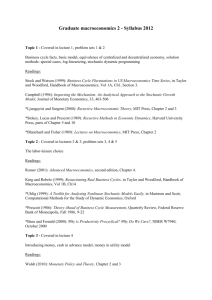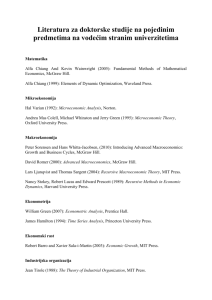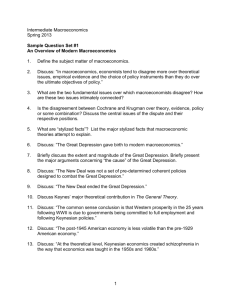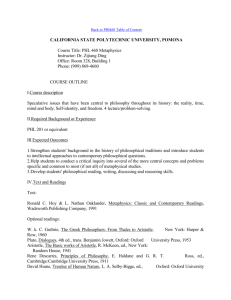SEMESTER II NAME OF COURSE: Macro Economics and Global
advertisement
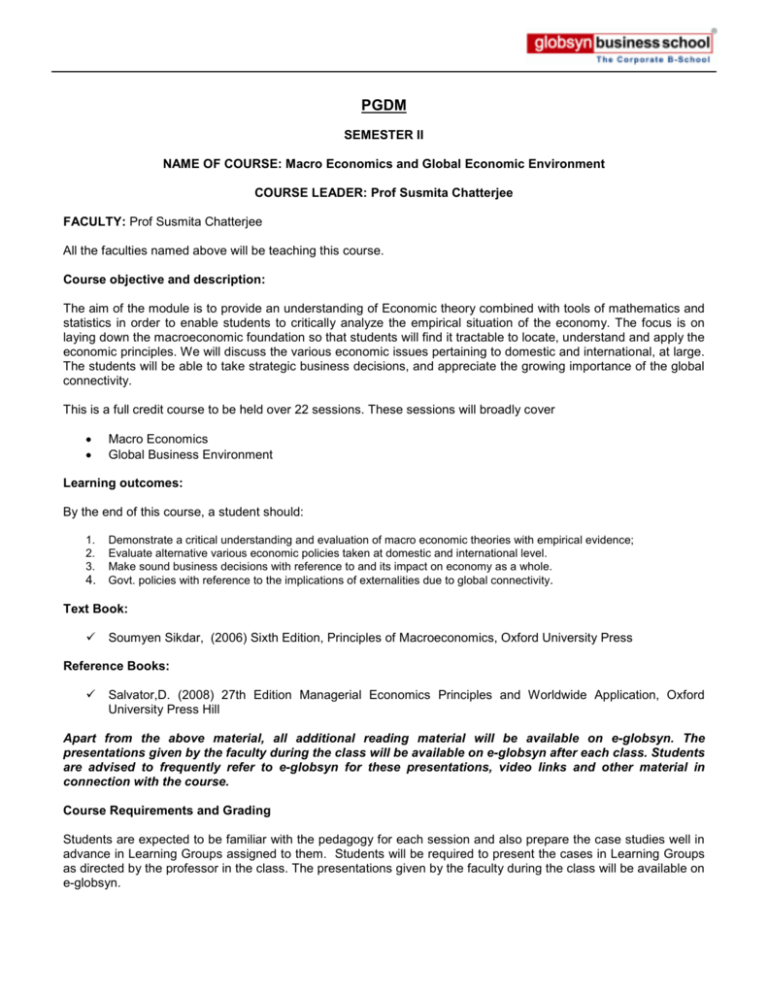
PGDM SEMESTER II NAME OF COURSE: Macro Economics and Global Economic Environment COURSE LEADER: Prof Susmita Chatterjee FACULTY: Prof Susmita Chatterjee All the faculties named above will be teaching this course. Course objective and description: The aim of the module is to provide an understanding of Economic theory combined with tools of mathematics and statistics in order to enable students to critically analyze the empirical situation of the economy. The focus is on laying down the macroeconomic foundation so that students will find it tractable to locate, understand and apply the economic principles. We will discuss the various economic issues pertaining to domestic and international, at large. The students will be able to take strategic business decisions, and appreciate the growing importance of the global connectivity. This is a full credit course to be held over 22 sessions. These sessions will broadly cover • • Macro Economics Global Business Environment Learning outcomes: By the end of this course, a student should: 1. 2. 3. 4. Demonstrate a critical understanding and evaluation of macro economic theories with empirical evidence; Evaluate alternative various economic policies taken at domestic and international level. Make sound business decisions with reference to and its impact on economy as a whole. Govt. policies with reference to the implications of externalities due to global connectivity. Text Book: Soumyen Sikdar, (2006) Sixth Edition, Principles of Macroeconomics, Oxford University Press Reference Books: Salvator,D. (2008) 27th Edition Managerial Economics Principles and Worldwide Application, Oxford University Press Hill Apart from the above material, all additional reading material will be available on e-globsyn. The presentations given by the faculty during the class will be available on e-globsyn after each class. Students are advised to frequently refer to e-globsyn for these presentations, video links and other material in connection with the course. Course Requirements and Grading Students are expected to be familiar with the pedagogy for each session and also prepare the case studies well in advance in Learning Groups assigned to them. Students will be required to present the cases in Learning Groups as directed by the professor in the class. The presentations given by the faculty during the class will be available on e-globsyn. Each student will also be required to make weekly submissions of assignments which will be put up in the eglobsyn. These assignments will generally be in the form of Multiple Choice Questions available on the e-globsyn There will be Project Presentations during the course. There will be two written examinations at the middle and the end of the Semester, as per the dates announced. A 2000 words report (50 %) will summarily assess intended learning outcomes.A 1.5 hours closed book examination based on analytical questions (50 %) will assess intended learning outcomes 1 & 2 Grading will be based on the following weights: The grading will be based on weekly submissions, presentations in Learning Groups, project performance and mid term and end-term examinations in the following manner: 1. 2. 3. 4. Coursework (20%) Midterm (30%) Final (40%) Online submission and class participation (10%) Every student in their Coursework must secure at least 35%. Examination Mark must be at least 35% and Module Mark must be at least 40%. Please note that no coursework will be marked until an identical electronic copy has also been submitted into the module web for a plagiarism check Session 1 Introduction This session would take off with an overview on the objective of studying Macro Economics. We would be discussing the Nature, Issues, Stability, Business environment. We will discuss about the Major Schools of thought Readings: Soumyen Sikdar, (2006) Sixth Edition, Principles of Macroeconomics, Oxford University Press Chapter- 1 Session 2 Measuring the Economy’s performance This session would introduce the most important macro variable- which is the gross domestic product. The study of GDP and its accounting will enable the students to appreciate the importance of GDP in the wellbeing at both micro and macro level Readings: Soumyen Sikdar, (2006) Sixth Edition, Principles of Macroeconomics, Oxford University Press Chapter- 2 Session 3 Measuring the Economy’s performance In this session the study of GDP and its accounting will enable the students to appreciate the importance of GDP in the wellbeing at both micro and macro level mainly in the context of India. Readings: Soumyen Sikdar, (2006) Sixth Edition, Principles of Macroeconomics, Oxford University Press, Chapter- 2 Session 4 Keynesian Economics: The Economy in the Short Run This session aims to introduce the Keynesian theory of general equilibrium. We introduce Simple Keynesian Model and the Keyenesian cross. We also derive the equilibrium and discuss comparative statics of government policies. Readings: Soumyen Sikdar, (2006) Sixth Edition, Principles of Macroeconomics, Oxford University Press, Chapter- 2 Session 5 Introduction to IS and LM curve This session aims to introduce the IS and LM curve to understand the equilibrium in the goods market and the money market After being introduced with the IS and LM curve, the two hands of the, In this session we will also see how the economy achieves equilibrium in both the markets namely the product market and money market at the intersection point of IS and LM curve. We will also see the adjustments in the economy takes place in terms of movements in the macro variables, to attain the equilibrium again from a dis-equilibrium state. Readings: Soumyen Sikdar, (2006) Sixth Edition, Principles of Macroeconomics, Oxford University Press, Chapter- 4 Session 6 Money, interest and income In this session we will discuss the concept of money, interest and their role in the economy in creating income. Readings: Soumyen Sikdar, (2006) Sixth Edition, Principles of Macroeconomics, Oxford University Press, Chapter- 4, 5 Session 7 Business Investment and case study Session 8 Fiscal and Monetary policy In this session you will be introduced to the two Government policies to control the economy. The first one is Fiscal policy which works through the real sector of the economy and the other one is Monetary policy, which works in terms of monetary variables Readings: Soumyen Sikdar, (2006) Sixth Edition, Principles of Macroeconomics, Oxford University Press, Chapter- 5 Session 9 Fiscal and Monetary Policy In this session we will emphasize our discussion on the working and impact of the Fiscal policy on the real sector of the economy in terms of shifts IS and LM curves. We will also show the relative effectiveness of the fiscal policy with respect to the shape of the IS curve based on the state of the economy Readings: Soumyen Sikdar, (2006) Sixth Edition, Principles of Macroeconomics, Oxford University Press, Chapter- 6 Session 10 Fiscal and Monetary policy Being introduced with the monetary policy in this session we will discuss the monetary variables through which Government influence the monetary sector of the economy in terms of shifts IS and LM curves. We will also show the relative effectiveness of the monetary policy with respect to the shape of the LM curve based on the state of the economy. Readings: Soumyen Sikdar, (2006) Sixth Edition, Principles of Macroeconomics, Oxford University Press, Chapter- 6 Session 11 Banking system, Supply of Money and the Conduct of the monetary policy In this session you will be introduced to the concept financial intermediaries and it’s role in controlling the money supply of an economy specially in terms of credit creation. We will also discuss the conditions for efficiency of the policy along with it’s limitations. Readings: Soumyen Sikdar, (2006) Sixth Edition, Principles of Macroeconomics, Oxford University Press, Chapter- 6 Session 12 Banking system, Supply of Money and the Conduct of the monetary policy In this session will introduce the concept of money along with the basic definitions of the different types of money, viz; M1, M2, M3 and its differences. We will also discuss the concept of money supply and it’s determinants and the role of banks to control it. With the acquired knowledge of money and banking operations, in this session, we will discuss the role of central bank of a country. We will discuss the same in case of India, namely the role of RBI. Readings: Soumyen Sikdar, (2006) Sixth Edition, Principles of Macroeconomics, Oxford University Press, Chapter- 6 Session 13 Opening up the Economy: In this session we will introduce the concept of Open economy and the reasons and states of economy which accounts for the opening up of the economies Readings: Soumyen Sikdar, (2006) Sixth Edition, Principles of Macroeconomics, Oxford University Press, Chapter- 7 Session 14 Opening up the Economy: In this session we will discuss the economic implication of Mundell Flemming Model. Readings: Soumyen Sikdar, (2006) Sixth Edition, Principles of Macroeconomics, Oxford University Press, Chapter- 7 Session 15 Case Study Readings: Soumyen Sikdar, (2006) Sixth Edition, Principles of Macroeconomics, Oxford University Press, Chapter- 3 Session 16 Fiscal and Monetary Policy, Demand and Supply shock With the acquired knowledge of basic Keynesian Cross, In this session, the students will be encouraged to derive the Aggregate demand curve. We will also introduce the external shocks which lead the AD curve to shift and lead to disequilibrium situation in the economy. Readings: Soumyen Sikdar, (2006) Sixth Edition, Principles of Macroeconomics, Oxford University Press, Chapter- 7, 8 Session 17 Fiscal and Monetary Policy, Demand and Supply shock Being introduced with the concept of the Aggregate demand curve in terms of simple Keynesian Model in this session we would introduce to the students with the concept of Supply with and determinants, followed by the derivation of supply curve. We will also introduce the external shocks which lead the AS curve to shift and lead to disequilibrium situation in the economy. Armed with the knowledge of both Aggregate demand and Aggregate supply the students will see the how the economy reached to the equilibrium at the intersection point of AD and AS curve of the economy. We will also show the macro factors influence the equilibrium situation and the rectifying policies to revert back the equilibrium. Readings: Soumyen Sikdar, (2006) Sixth Edition, Principles of Macroeconomics, Oxford University Press, Chapter- 7, 8 Session 18 The problem of Inflation: In this session we will analyse the concept of inflation followed by a detailed discussion of the caused behind this. Readings: Soumyen Sikdar, (2006) Sixth Edition, Principles of Macroeconomics, Oxford University Press, Chapter- 9 Session 19 The problem of Inflation: Armed with the concept of inflation in this session will be discussing the different measures generally adopted by the central bank of the country with a special emphasis on RBI. Readings: Soumyen Sikdar, (2006) Sixth Edition, Principles of Macroeconomics, Oxford University Press, Chapter- 9 Session 20 Growth, Globalization and Environment In this session we will analyse the growth models and its implication in the context of GDP growth across the world and the determinant variables like savings and investment. Readings: Soumyen Sikdar, (2006) Sixth Edition, Principles of Macroeconomics, Oxford University Press, Chapter10 Session 21 Growth ,Globalisation and Environment In this session we will discuss the impact of globalization on economy and behavior of economic agents. Readings: Soumyen Sikdar, (2006) Sixth Edition, Principles of Macroeconomics, Oxford University Press, Chapter10 Session 22 Case Study

